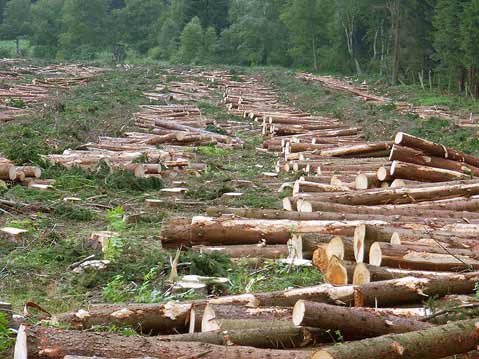Peak Wood
The Importance of Being a Forest

Today’s sustainable energy advocates could learn a lot from studying the way ancient societies had to deal with the first global energy crisis: peak wood. The oil of its day, wood served as the principal fuel of our ancestors, who scoured the planet, fought wars, and exhausted their wealth to obtain it.
The Romans, for example, delayed peak wood by expanding their empire into wood-rich areas like France, Spain, and Germany. The English did the same by colonizing North America. Unfortunately, other societies were not as lucky. Once Athens lost its hold on accessible supplies of timber, it became subservient to wood-rich Macedonia.
Many societies turned to the sun for warmth when wood became more difficult to come by. In Greece, 2,500 years ago, most cities were planned so solar energy could heat every home in winter. Perhaps we will have to do the same as we run out of oil.
The British ran out of accessible wood supplies in the 18th Century and turned to coal as a substitute, marking the beginning of the age of fossil fuels. But as the production of fossil fuels peaks today, modern civilization faces a similar predicament to the situation those dependent on wood encountered with the felling of their forests.
Like our ancestors’ cutting down the woods for material development, our reliance on fossil fuels today threatens our nation’s security as well as our planet’s well-being. The combination of accelerated deforestation and burning of coal and oil over the last 250 years has resulted in the climate change crisis we face today. Ironically, we depend more on forests today for our survival than did our ancestors when wood reigned supreme as society’s principal resource.
Deforestation beats out vehicular emissions as a cause of worldwide warming. In fact, loss of forests, and their conversion to other uses, since 1850 has contributed more carbon to the atmosphere than any other activity except the burning of fossil fuels for generating electricity. Trees left to grow to maturity hold more carbon than trees left standing for only several decades, as has been the practice of industrial forestry. Furthermore, the soil underneath the forest stores great amounts of carbon as well. Disturbing this carbon by clearing the forests for agriculture or for livestock grazing also adds to the global warming problem, as does industrial forestry with its clear-cuts, road building, and intrusion of machinery to collect felled logs.
Deforestation also endangers other vital and increasingly scarce resources: fresh water and fertile soil. Old-growth forests rate as the best cover for watersheds. They excel at filtering out impurities, regulating the flow of water throughout the year, and preventing sedimentation. Researchers have found ways to value a forest’s worth in protecting the supply of water throughout the world. A 2003 report calculated the value of that service at $2.3 trillion: nearly six times the worth of today’s timber trade.
Recognizing the value of old growth to keep water supplies clean and available, the private and public sectors have begun investing in keeping such forests intact. The bottlers of Perrier, for example, purchased heavily farmed watersheds near the source of their water and reforested them to protect the integrity of their product. Likewise, New York City has found it far less expensive to buy up conservation easements along its watersheds, guaranteeing the preservation of forests to keep the city’s water to the same quality as would proposed water filtration plants, saving the city billions of dollars.
Deforestation, on the other hand, results in large-scale erosion, loss of soil nutrients and, sometimes, total desertification. Examples of this extreme outcome can be seen on Madagascar’s central highland plateau, where about 7 percent of the country’s total land mass has become barren, sterile ground. It can also be seen in certain deforested and overgrazed portions of our own Santa Ynez valley.
Studies have shown that saving the Amazon, for example, can be a cheaper and faster way to mitigate the consequences of global warming than replacing coal-fired power plants with renewable energy. One such study by the World Bank/World Wildlife Fund argues that halting its deforestation would cost around $18 billion—saving a trillion dollars that would have to be expended to halt global warming by other strategies.
That’s not to say we shouldn’t follow in our ancestors’ footsteps to replace burning fuel with the power of the sun. Although most ancient Greeks considered fire a gift (stolen or not) from the gods, the 8th-century BCE poet Hesiod disagreed, predicting that the human race’s use of fire would one day become a great plague. Perhaps Hesiod’s nightmare is coming true today in the guise of global warming.
John Perlin authored, among other works, A Forest Journey: The Story of Wood and Civilization, chosen by Harvard University Press as one of its top “One Hundred Great Books.” He can be reached at johnperlin@physics.ucsb.edu.



